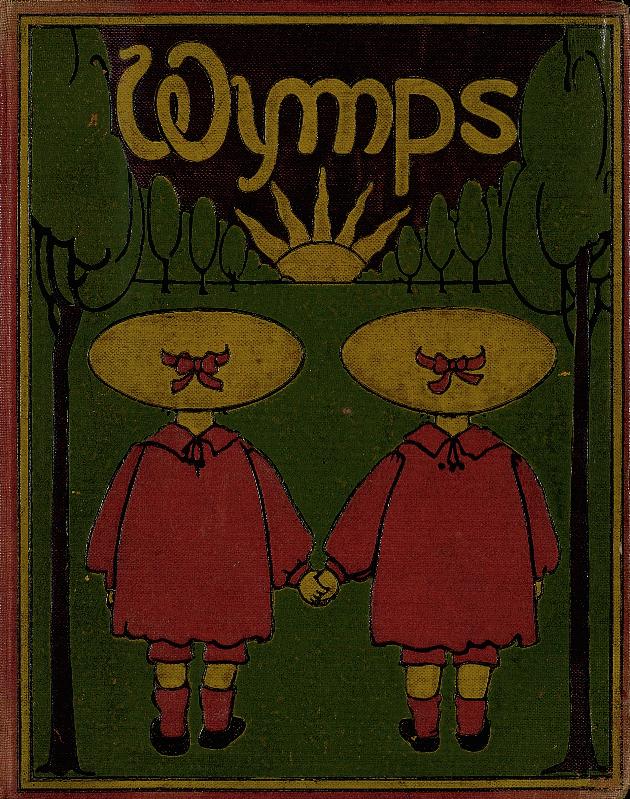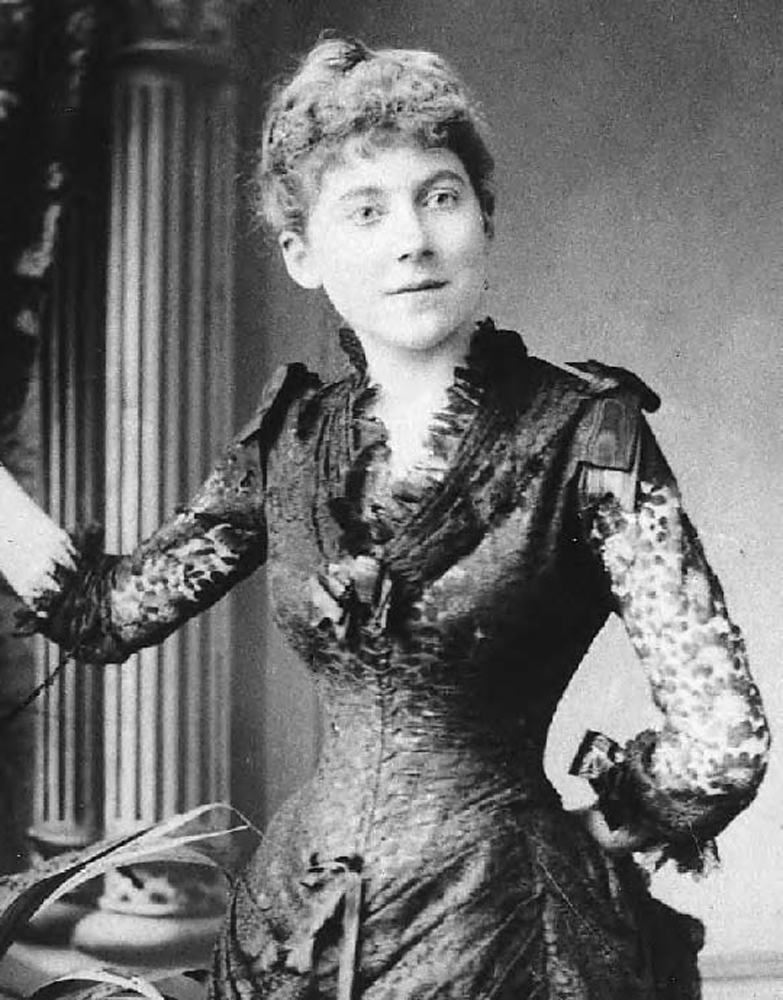The novelist, playwright, and children’s book illustrator Mabel Dearmer was born Jessie Mabel Pritchard White on March 22, 1872. Her parents were Surgeon-Major William White and Selina Taylor (Pritchard) White of Caernarvon, Wales. She grew up isolated but spirited and ambitious, aspiring first towards a career in theatre and then towards one in the visual arts. She attended Sir Hubert von Herkomer’s art school in Bushey, North London in 1891, but left upon her marriage to the Rev. Percy Dearmer (1867-1936) the following year. During the next two decades, the Dearmers pursued a vibrant cultural and political life. A curate and then vicar in Lambeth, South London, Mabel’s husband was appointed minister of St-Mary-The-Virgin, Primrose Hill in 1901. They resided there until 1915, raising two sons, Geoffrey (1893-1996) and Christopher (1894-1915). The Dearmer marriage rested on shared ideals of socialism, pacifism, and feminism.
By all accounts, Mabel Dearmer was an inspired and energetic personality, and these qualities surface in her illustrative art of the 1890s. In 1896 and 1897, she contributed images to The Yellow Book, The Savoy, and The Studio. Upon Aubrey Beardsley’s departure as editor of The Yellow Book, she became the first woman to create a cover and title page for the magazine (vol. 9). Although she designed bookplates, bindings, and posters, her forté in the 1890s was children’s book illustration. In 1897 and 1898 respectively, Dearmer illustrated her friend Evelyn Sharp’s Wymps, and Other Fairy Tales and All the Way to Fairyland, both published by John Lane (1854-1925) at the Bodley Head. She followed these with her own Round-about Rhymes (1898), The Book of Penny Toys (1899), and The Noah’s Ark Geography (1900). Also of note are her illustrations to Laurence Housman’s popular The Story of the Seven Young Goslings (1899).

In contrast to the ornamental style of many other late-Victorian illustrators, Dearmer’s images appear strikingly modern. Male contemporaries minimized her talent as a draftsperson, but viewers were captivated by her vibrant colour choices and often eerie landscapes. Further elements of her style include a deliberate asymmetry, allusions to Japanese art, bold colour blocking, and the use of heavy outline.
Dearmer’s greatest inspiration seems to have been Beardsley’s poster art. One critic declared, with sardonic allusions to James McNeill Whistler (1834-1903) and George Egerton (1859-1945), that the “illustrations are rather wonderful and fearful, Mrs. Pearcy [sic] Dearmer having evidently studied in the Aubrey Beardsley School, and being addicted to harmonies — or discords — in the brightest yellow” (“Christmas”). Dearmer’s use of the figures of Pierrot and Pan for drawings in The Studio (1897) and The Savoy (1896) reveals her awareness of them as decadent tropes. Such associations with decadence, however, neither hurt her book sales, nor tarnished her reputation or her husband’s as a cleric.
The couple sustained long-term friendships with Housman (1865-1959), Sharp (1869-1955), Stephen Gwynn (1864-1950), and Netta Syrett (1865-1943). Mabel also befriended The Yellow Book’s literary editor Henry Harland (1861-1905), designing the binding of his Comedies & Errors, published by the Bodley Head in 1898. She even hosted a salon for The Yellow Book ’s insiders, which Sharp dubbed “Mabel’s lurid Mondays” (Gwynn, Experiences 138).
Following her friend Housman’s account in The Unexpected Years (129), modern critics might be tempted to bifurcate her life: to read her as a dauntless artist of the nineties who, after her husband’s 1901 appointment and move to a more affluent neighborhood, compromised her art and radical spirit, devoting time instead to parish activities. Such a reading would be reductive. First, Dearmer’s passion for social service preceded her marriage. A year after she met Percy Dearmer at age 16, both volunteered during the 1889 Dock Strike, serving families meals at the Christ Church Mission in the East End. During the 1890s, even as she contributed drawings to avant-garde magazines, she was also illustrating Anglican periodicals edited by her husband and his fellow clergy.
Further, the union of ethics and aesthetics undergirded the Dearmer marriage. As a Christian Socialist, Percy allied himself with Ritualist ministers who had created a specialized venue for ecclesiastical arts and crafts. He advised on the design of materials from vestments to altar frontals. He also strengthened his wife’s aesthetic alliances: she initially befriended Richard Le Gallienne (1866-1947) through him. And as his interest in hymnology grew, Percy consulted with Evelyn Sharp’s brother, Cecil (1859-1924), the collector of folk ballads, on the road to his crowning work in indexing Anglican hymns with Ralph Vaughan Williams.
Mabel Dearmer’s own fusion of good works and good art appears most vividly through her religious stories for children and scripting and producing of mystery plays and children’s plays. Her contemporaries recalled her natural instinct for the theatre. A trained elocutionist, she had offered public readings in 1894 of Henrik Ibsen’s Brand (1865), a play whose themes anticipate those in her own later fictions (she also produced the promotional poster for the readings herself). Inspired by a passion play she attended in Germany in 1910, she founded the Morality Play Society in 1911, mounting productions of her plays The Soul of the World (1911) and The Dreamer (1912). Adept at directing children in parish Christmas plays, she revised her Noah’s Ark Geography as a children’s play, entitled The Cockyolly Bird and published as a book in 1914. She also staged multiple productions of her Brer Rabbit and Mr. Fox (1914).
Dearmer’s negotiations between aestheticism and Christian altruism seem also to have inspired two of her novels, Gervase (1909) and the autobiographical The Difficult Way (1905). Here, protagonists struggle to live both ethically and in accordance with their aesthetic sensibilities (though in Gervase’s case, his sensibility is admittedly more ascetic than aesthetic). Dearmer’s novels for adults, published between 1902 and 1909, vary widely in style and quality. Besides The Difficult Way and Gervase, they include the nostalgic tribute to childhood and family life The Noisy Years (1902) and its sequel Brownjohn’s (1906), the historical romance The Orangery: A Comedy of Tears (1904), and the sensationalistic novel of illegitimacy and betrayal The Alien Sisters (1908).
A lifelong pacifist, Dearmer was initially indifferent to the events that led up to the First World War. However, after their two sons enlisted, her husband volunteered his services as chaplain to the British Red Cross, and Dearmer decided to accompany him. She contracted typhoid and pneumonia and died while serving as a nursing orderly in Serbia in 1915. Her war experiences are recorded in her posthumously published Letters from a Field Hospital (1915). Mabel was not the only casualty in the family. Her younger son, Christopher, died of wounds in Gallipoli three months after her death. Her elder son, Geoffrey, a celebrated World War I poet, lived to be 103.
Despite her significant contributions to 1890s aestheticism, Mabel Dearmer was, until relatively recently, a forgotten figure to all but a few book collectors and specialists in children’s book illustration. She has, however, been the subject of a public lecture (Shefrin) and several blog entries by Cambridge University library cataloguers (Tower Project). Her one extant poster appeared in an exhibition in 2003 and has been reproduced in its catalogue (Stetz). The Baldwin Library of Historical Children’s Literature at the University of Florida has digitized Wymps. Given the propensity of young children to tear and deface their books, few of her original picture books have survived intact. Pristine hard copies are now rare collectibles.
© 2012, 2022, Diana Maltz, Southern Oregon University
Diana Maltz is a Professor of English at Southern Oregon University. Her book, British Aestheticism and the Urban Working Classes: Beauty for the People, 1870-1900 , was published by Palgrave Macmillan in 2006. Her essay on Mabel Dearmer is forthcoming in Extraordinary Aesthetes: Decadents, New Women, and Fin-de-Siècle Culture , ed. Joseph Bristow (University of Toronto Press, 2022).
Selected Publications Written and Illustrated by Mabel Dearmer
- The Book of Penny Toys. London: Macmillan, 1889.
- The Noah’s Ark Geography. 1909. London: Macmillan, 1939.
- Round-about Rhymes. London: Blackie & Son, 1898.
Selected Publications Written by Mabel Dearmer
- The Alien Sisters. London: Smith, Elder, 1908.
- Brer Rabbit and Mr. Fox: A Musical Frolic. London: Joseph Williams, 1914.
- Brownjohn’s. London: Smith, Elder, 1906.
- A Child’s Life of Christ. Illus. Eleanor Fortescue-Brickdale. London: Methuen, 1896.
- The Cockyolly Bird. The Book of the Play. London: Hodder and Stoughton, 1914.
- The Difficult Way. London: Smith, Elder, 1905.
- The Dreamer: A Drama of the Life of Joseph. London: A. R. Mowbray, 1912.
- Gervase. London: Smith, Elder, 1909.
- Letters from a Field Hospital. London: Macmillan, 1915.
- The Noisy Years. Illus. Eva Roos. London: Smith, Elder, 1902.
- The Orangery. A Comedy of Tears. London: Smith, Elder, 1904.
- The Playmate. A Christmas Mystery Play. Illus. Helen Stratton. London: A. R. Mowbray, 1910.
- The Soul of the World. A Mystery Play of the Nativity and the Passion . London: A. R. Mowbray, 1911.
Selected Illustrations and Publications with Illustrations by Mabel Dearmer
- Cover Illustration and Title Page. The Yellow Book 9 (April 1896).
- “The Muslin Dress.” The Yellow Book 12 (January 1897): 188.
- “Pierrot and Pierrette.” The Studio 11 (1897): 262.
- Harland, Henry. Comedies & Errors. Binding Design: Mabel Dearmer. London: John Lane, The Bodley Head, 1898.
- Housman, Laurence. The Story of the Seven Young Goslings . Illus. Mabel Dearmer. London: Blackie & Son, 1899.
- Sharp, Evelyn. All the Way to Fairyland. Illus. Mabel Dearmer. London: John Lane, The Bodley Head, 1898.
- —. Wymps and Other Fairy Tales. London: John Lane, The Bodley Head, 1897.
Selected Publications about Mabel Dearmer
- Anon. “Christmas Bookshelf.” The Graphic. 1464 (Dec. 18, 1897): 800-02. Print.
- Dearmer, Nan. The Life of Percy Dearmer. London: The Book Club, 1941. Print.
- Gwynn, Stephen. Experiences of a Literary Man. London: T. Butterworth, 1926. Print.
- —. “Memoir.” Letters from a Field Hospital. By Mabel Dearmer. London: Macmillan, 1915. 1-73. Print.
- Housman, Laurence. The Unexpected Years. London: Jonathan Cape, 1937. Print.
- Shefrin, Jill. “‘Dearmerest Mrs. Dearmer’: A lecture given at the Osborne Collection in Lillian H. Smith branch, April 22, 1999.” Toronto: Friends of the Osborne and Lillian H. Smith Collections at the Toronto Public Library, 1999. Web. 24 June 2012. <http://www.teetotum.ca/DearmerestMrsDearmer.pdf.>
- Stetz, Margaret D., Gender and the London Theatre, 1880-1920 . High Wycombe, Buckinghamshire: Rivendale, 2004. Print.
- Tower Project. “Mabel Dearmer: an unexpected gem.” Tower Project Blog. Cambridge University Library. 10 August 2010. Web.24 June 2012. <http://vl203.wordpress.com/2010/08/10/mabel-dearmer-an-unexpected-gem/>
- —. “Mabel Dearmer: an unusual life (Part 1).” Tower Project Blog. Cambridge University Library. 16 August 2010. Web. 24 June 2012. <http://vl203.wordpress.com/2010/08/16/mabel-dearmer-an-unusual-life-part-1/>
- —. “Mabel Dearmer: an unusual life (Part 2).” Tower Project Blog. Cambridge University Library. 23 August 2010. Web. 24 June 2012. <http://vl203.wordpress.com/2010/08/23/mabel-dearmer-an-unusual-life-part-2/>
- —. “Mabel Dearmer: here be dragons.” Tower Project Blog. Cambridge University Library. 26 August 2010. Web. 24 June 2012. <http://vl203.wordpress.com/2010/08/25/mabel-dearmer-here-be-dragons/>
MLA citation:
Maltz, Diana. “Mabel Dearmer (1872-1915),” Y90s Biographies , 2012. Yellow Nineties 2.0, edited by Lorraine Janzen Kooistra, Ryerson University Centre for Digital Humanties, 2019, https://www.1890s.ca/dearmer_bio/.
